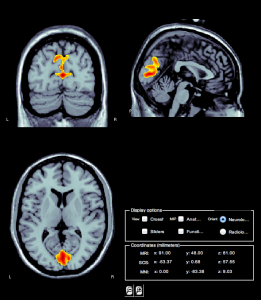![]() Research line coordinated by Stephan Moratti.
Research line coordinated by Stephan Moratti.

Cortical activity of early visual cortex to fear relevant stimuli
My team and me are investigating basic neuronal mechanism of emotional processing in the brain. We are interested in how emotional relevance influences perceptual processes in the brain. We are also interested in basic fear learning mechanism. One major question within this research line is how emotional processing is affected in affective disorders such as depression. However, to understand better how emotion influences perception we also study basic perceptual processes in the visual system.
We work in close collaboration with the Clinical Neuroscience Laboratory.
We use techniques like Magnetoencephalography (MEG), Electroencephalography (EEG), and intracranial EEG recordings.
Our team applies advanced cortical source localization techniques to MEG/ EEG data in the time and time-frequency domain. We also use functional and effective connectivity measures to estimate neuronal coupling derived from MEG/ EEG data.
Post-Docs:
- Karolina Swider (Marie Sklodowska Curie fellow)
Doctoral students:
- Cristina Saugar, PhD (finished)
- Constantino Méndez Bértolo, PhD (finished)
- Ana Galarza, PhD (finished)
- Javier Echegaray (in course)
- Alejandro Santos Mayo (in course)
- Inés Abalo Rodríguez (in course)
Master students:
- Tamara Giménez Fernández (finished)
- Javier de Echegaray y Díaz de Otazu (finished)
- Alejandro Santos Mayo (finished)
- Myriam Joana Laremont Bumedien (finished)
- Iciar Celaya Morón
Collaborating students (UCM):
- Morika Georgieva
- Maria Modelska
- Belén Benito
- Raluca Andreea Stan
Visiting Students:
- Melissa Yuan (Boston, USA)
- Luianta Verra (Berlin, Germany)
- Katharina Teutenberg (Germany)
Recent Projects:
- TEMPACOR (Ministerio de Economía y Competitividad; PSI2014-52205-R). IP: Stephan Moratti. Investigates oscillatory neuronal responses to emotional pictures in depressed and healthy participants.
- EYEBAM (Ministerio de Economía y Competitividad ; PSI2017-91700-EXP). IP: Stephan Moratti. This explorer project tries to show that amplitude modulated steady state responses can affect startle responses to affective pictures.
- EICor (Ministerio de Ciencia, Innovación y Universidades; PGC2018-097940-B-I00). IP: Stephabn Moratti. In this project we investigate neuronal oscillatory response modulations by fear conditioning. Specifically, we are interested in the acquisition of conditioned inhibitory responses.
- Neurocon (European Union). Ips: Karolina Swider and Stephan Moratti. This European funded project investigates how placebo effects can be induced to reduce pain perception by fear conditioning.

